|
|
|
|
7000-series Gallery 1
7000 Gallery 1 | 7000 Gallery 2 | 7000 Gallery 3 7000 Gallery 4 | 7000 Gallery 5 | 7000 Gallery 6 7000 Gallery 7 | 7000 Gallery 8 | 7000 Gallery 9 |
|
|
|
|
7000-series Gallery 1
7000 Gallery 1 | 7000 Gallery 2 | 7000 Gallery 3 7000 Gallery 4 | 7000 Gallery 5 | 7000 Gallery 6 7000 Gallery 7 | 7000 Gallery 8 | 7000 Gallery 9 |
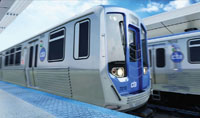 |
cta7000s_rendering-Ext01.jpg (131k) |
 |
cta7000s_rendering-Ext02.jpg (118k) An early artist's rendering of the 7000-series 'L' cars shows the side of the proposed cars. Generally, it was the same as the previous 5000-series cars, with its 'fishbelly' curved profile, fluted lower side panels, and hopper windows, as well as the same arrangement of outside signal lights, speakers, vents, and grab-bars. Other graphic details, such as the placement of the CTA logo and the use of amber LED destination signs instead of full-color LED signs, can probably be taken as artistic license, and not literal. (Image courtesy of CTA) |
 |
cta7000s_rendering-Ext03.jpg (116k) This artist's rendering of the front end of the proposed 7000-series railcars show the first design for the new end cap that was proposed by CSR America, giving the cars a more modern appearance that is markedly different than its predecessors, but similar to many contemporary car orders for other major rapid transit systems. The arrangement of the headlights is not only different, but note that there are only two marker lights on each side instead of four -- presumably, one is red (for when it is the rear of the train, as is current procedure) and the other can produce the other three colors necessary (white, green and amber). The end cap design was further refined and developed before being finalized. Although the LED destination sign is shown as being monochrome, it would actually be full-color as the 5000s' are to produce the line color backgrounds. (Image courtesy of CTA) |
 |
cta7000s_rendering-Int01.jpg (178k) An interior view of the proposed 7000-series railcars is shown in an artist's rendering looking down the aisle from the front toward the rear of the car. The three sections of the car -- between the ends and the nearest side doors, and between the two sets of side doors -- each have a different seating configuration: from the front, in the foreground, to the rear, the cars have a section of longitudinal seating (like the 5000s), a section of 2 x 1 seating (like the 3200s) in the middle, and a section of 2 x 2 seating (like the 2600s and others) in the rear section. Note the spring-loaded New York subway-style hand holds in the ceiling in the door areas, and the digital screen over the aisle in the middle. Different renderings show different seat insert colors; this concept shows blue inserts. (Image courtesy of CTA) |
 |
cta7000s_rendering-Int02.jpg (150k) An artist's rendering of the proposed 7000-series car interior shows the rear section of the car, between the #4 side doors and the #2 (rear) end of the car. A set of double aisle-facing seats are on either side of the doors, as on all other car series, and the rear section has 2 x 2 seating, e.g. double-seats on both sides of the aisle. Note that the modesty panels next to the doors don't extend all the way to the floor, giving the interior a more open feel and making the area by the doors seem less closed off, as well as making it easier to clean this part of the car floor. (Image courtesy of CTA) |
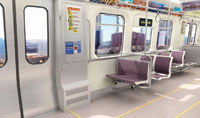 |
cta7000s_rendering-Int03.jpg (147k) A digitally-generated conceptual view of the interior of the 7000-series shows what the middle section of the car, between the two sets of side doors, is proposed to look like. This section of the car has 2 x 1 seating, with double seats on one side of the aisle and single seats on the other, switching halfway through the section. The seats nearest to the front of the car are flip seats for wheelchair securement. This rendering shows purple seat inserts, one of three color variants shown in different renderings. Note the digital screen over the aisle, in the top right. (Image courtesy of CTA) |
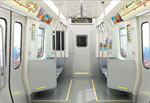 |
cta7000s_rendering-Int04.jpg (140k) This conceptual rendering of the 7000-series railcar interior looks toward the front of the car and the motorcab. This section of the car has aisle-facing longitudinal seats. An LED panel in the end bulkhead provides visual messaging to complement the prerecorded audio announcements, for ADA-compliance. Note the spring-loaded New York subway-style hand holds shown in the ceiling in the door areas and that the modesty panels next to the doors don't extend all the way to the floor, giving the interior a more open feel and assisting with cleaning the floor. (Image courtesy of CTA) |
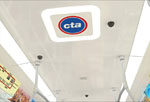 |
cta7000s_rendering-Int05.jpg (84k) A artist's rendering giving a conceptual view of the interior of the 7000-series railcars is a detail view of the ceiling, showing recessed lighting along the sides supplemented by a unique type of the light fixture in the center decorated with a CTA logo. (Image courtesy of CTA) |
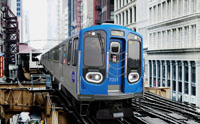 |
cta7000s_rendering_rev2017-Ext01.jpg (274k) In 2017, revised renderings of the forthcoming 7000-series cars were released by CTA. The car design was largely the same, but the front end cap was further refined, including small changes to the head/tail light arrangement and black masking around the windows. The blue color also now extended to the bottom, rather than angling inward at the bottom leaving the bottom corners gray. (Image courtesy of CTA) |
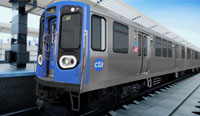 |
cta7000s_rendering_rev2017-Ext02.jpg (822k) A revised exterior rendering of the planned 7000-series cars from 2017 shows the design with small refinements that would largely reflect how the cars were actually look when they were manufactured. (Image courtesy of CTA) |
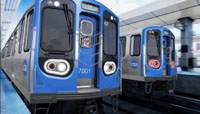 |
cta7000s_rendering_rev2017-Ext03.jpg (216k) This updated rendering of the 7000-series cars from 2017 shows how the end light arrangement was intended to work -- when at the front of a train, the headlights be on and a ring around the light modules would also be illuminated white; when the car is at the rear of the train, not only would the red taillights be on but the lighted ring around the lights would be illuminated red instead for added visibility and aesthetic effect. (Image courtesy of CTA) |
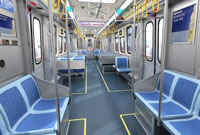 |
cta7000s_rendering_rev2017-Int01.jpg (611k) The interior arrangement of the planned 7000-series cars is largely final and as it would be built in this updated 2017 rendering. The seating arrangement is finalized (longitudinal at the front, foreground; 2 x 1 seating in the center; and 2 x 2 seating at the rear end, background), the overhead handholds are straps rather than metal grips like in earlier renderings (except at the side doors, where the metal ring grips remain), and other details are consistent with the standards for CTA railcars. One element that still was not as it would be built were the modest panels and windscreens betweens the side doors and adjacent seats -- here, the modesty panel (the solid side panel) is low and angled, still providing an solid panel at a sitting person's leg/thigh area for, well, modesty, but low and angled to provide a more open feel and look, with a plain glass windscreen above it. In the final version of the car, this entire assembly would be replaced with a glass panel with no solid metal lower section. (Image courtesy of CTA) |
|
|